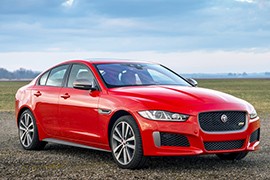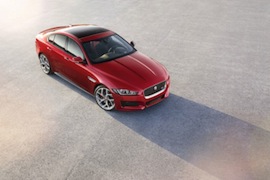JAGUAR XE Models/Series Timeline, Specifications & Photos
First production year: 2015
Engines: Diesel, Gasoline
Four years after being introduced as the first Jaguar to sport the XE moniker, the entry level sedan has received a mid cycle facelift that features a revamped design, a more luxurious cabin and a ton of technology features that improve the model on every level.
With some of the new design motifs being inspired by the F-Type sports car, the facelifted Jaguar XE appears wider and lower than before, with larger front apertures, bold graphics and muscular forms eluding to the car's increased performance and improved aerodynamics. The front end features a redesigned bumper and new LED headlights with a more aggressive 'J' blade daytime running light signature.
The XE's rear also features a new design for the bumper and slimmer full LED tail lights that have an updated signature graphics. All the design modifications enforce the visual width of the car, giving the XE a more planted appearance.
The redesigned interior features extensive use of soft-touch materials, premium veneers and all-new door trims that improve usability and practicality as much as they look good. Shared with the F-Type, the JaguarDrive Control Switch and SportShift gear selector for automatic models give the car a more high-tech feel, while the new steering wheel, shared with the all-electric I-PACE, features hidden-until-lit graphics and tactile switches for intuitive control of key functions.
While it was no match for the German competition formed by the BMW M3 and the Mercedes-Benz C-Class AMG, the Jaguar offered a good balance between luxury, performance, and price.
Jaguar developed the XE as a direct competitor for the BMW 3-Series and the Mercedes-Benz C-Class. The carmaker offered it with gasoline and diesel engines, with rear- or all-wheel-drive. It was a premium compact sedan that had something for anyone, but there was the last piece to complete the puzzle: a sport version. And that was the XE300: the last piece of the puzzle.
From the exterior, the XE 300 Sport didn't look too much different than its siblings. It didn't feature any screaming for attention wings, or massive spoilers—only a small badge on the mesh-grille at the front and a slightly different front bumper. A small lip-spoiler was added on the trunk lid, but that was available for the rest of the range from the options list.
The interior featured sport-bucket seats with the XE Sport lettering embroiled on the headrests. Its black leather with contrast stitching was fitted as standard, an option that was not available for the rest of the range. But from the exterior, it was hard to notice that.
While the exterior tried to fly under the radar, the drivetrain was a different story. Jaguar dropped the inline-four Ingenium gasoline engine. Its turbocharged 2.0-liter provided 300 hp, which were sent in all four corners via an 8-speed automatic transmission. That said, it offered plenty of performance and grip on loose surfaces, especially for a daily driver.
While most other German automakers kept their conservative design, Jaguar dared to be different and introduced the XE model in its range in 2015 as a fresh addition to its lineup.
The British automaker was on the verge of evolution. After throwing away its older design books when it launched the XF, it continued with the XJ and then launched the XE. It also killed the X-Type lineup in the process. So, the new model targeted young customers who cared about brands, didn't like the sober look of the German cars, but loved technology. So Jag gave them all of these.
With its narrowed down towards the car's front fascia's center and the overall angry look, the XE looked stunning for its year. Its main grille sported a mesh design, and the cooling area was expanded on the lower bumper with an additional air intake flanked by a pair of scoops that channeled air toward the front rotors. From its profile, the ascending beltline ended at the back of the car with a short deck. One of the reasons why the car looked that sporty was the short greenhouse, and that affected the interior.
Due to the low roof, there was limited headroom for the rear-seated passengers. At the front, on the other hand, the driver had plenty. The car came fitted as standard with many safety options such as automatic braking and lane-changing assistant. Inside the instrument cluster, the TFT display placed between the analog speedometer and the tachometer looked excellent. Jaguar also added the raising rotary knob for the gear selector, which was a unique feature in the segment.
For the drivetrains, Jaguar opted for diesel and gasoline engines ranging between 163 and 340 PS (160 and 335 hp), with rear or all-wheel drive.


